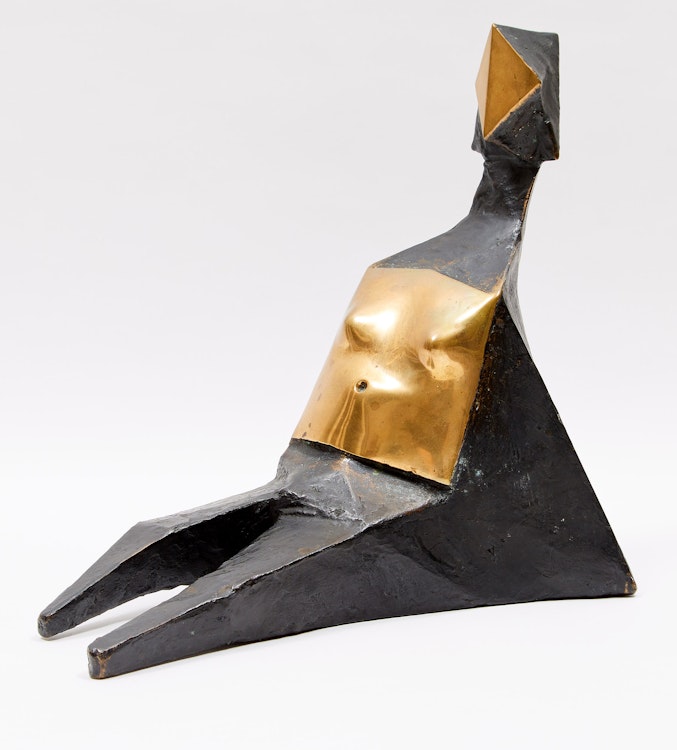Maquette VI Sitting Elektra (Farr & Chadwick 583) by Lynn Russell Chadwick

Lynn Chadwick
Maquette VI Sitting Elektra (Farr & Chadwick 583)
bronze
signed, dated 1969, numbered 2/6 and inscribed “583” to the underside
11.75 x 12.5 x 8.5 ins ( 29.8 x 31.8 x 21.6 cms ) ( overall )
Auction Estimate: $30,000.00 - $50,000.00
Price Realized $25,000.00
Sale date: November 30th 2021
Private Collection, Toronto
Dennis Farr & Éva Chadwick, “Lynn Chadwick Sculptor, With a Complete Illustrated Catalogue 1947-2005”, Lund Humphries, 2006, page 12, illustrated page 262, cat. no. 583
Terence Mullaly, “Lynn Chadwick”, Obituary, The Guardian, April 28, 2003
Joan Collins, The Collection at Lypiatt Park: Lynn Chadwick. Ruder Finn Press, New York, 2006, page 22
In the artist’s obituary, Terence Mullaly writes: “His simplified human figures have already stamped themselves upon the artistic imagination and have come to stand as symbols.” The author goes on to explain why these figural works are so important: “This is a clue as to why his simplifications work so well both in his monumental pieces and in small bronzes. The female head is reduced to a triangle, the legs are straight and spiky, drapery is shown as an austere sweeping form, but the essentials of structure or movement are conveyed. Whether larger-than-life size or reduced down to the scale of a medal, the essentials of the image are clear.” Chadwick’s approach to sculpture was constructive and additive, rather than subtractive modeling. He first made a linear armature or skeleton onto which he applied a skin, building up the surface to a solid form.
At the 1956 Venice Biennale, Lynn Chadwick was granted the International Prize for Sculpture, becoming, at age 41, the youngest recipient of the award. Many in the art world were shocked at Chadwick's selection, having assumed that Swiss sculptor Alberto Giacometti (1901-1966) would win. This achievement confirmed his international reputation in the art world. During the remainder of the decade, Chadwick was prominent among the group of metal sculptors following in the steps of Henry Moore whose works, although largely abstract, carried suggestions of the human figure. In the 1960s his work became more block-like and monumental, designed to be seen in the open. “Maquette VI Sitting Elektra” dating to 1969, demonstrates this new direction taken by Chadwick.
The work was cast in bronze, a medium the artist had recently adopted in the late 1950s. During this period, Chadwick was the sole technical force in the production of his work. He did not produce preparatory sketches, rather he improvised the works as he went through the sculpting process. “Maquette VI Sitting Elektra” is a product of Chadwick’s newfound confidence and refined skills, arriving at a mature point in his career. In a catalogue essay on an exhibition on Chadwick at the Museum of Modern Art in Rio de Janeiro in January 1962, Herbert Read noted that Chadwick has consolidated his style, saying ..."He is still preoccupied with states of attention or alertness in the human figure or the animal. His aim is to incorporate a moment of maximum intensity, and this he does by the most direct means – the reduction of bodily attitudes to their magnetic lines of force..."
Share this item with your friends
Lynn Russell Chadwick
(1914 - 2003)
Lynn Russell Chadwick was a 20th century British artist, highly renowned for his skeletal iron and bronze sculpture, often of abstracted animal and humanlike forms. He originally trained as an architectural draftsman, which was the only formal education Chadwick ever received as an artist. He recalled: "What it taught me was how to compose things, a formal exercise in composition, really, it has nothing to do with the building it represents".
In April 1941, Chadwick volunteered to serve in the Fleet Air Arm, and in 1941–1944 he served as a pilot during the Second World War escorting Atlantic convoys. After the war, Chadwick returned to England, working for Rodney Thomas, who helped him find his beginnings as a sculptor. He became involved in the design of exhibition stands and textile design, and in 1947, with the encouragement of Thomas, constructed his first mobile.
After studying welding in the early 1950s, however, Chadwick turned to stable metal constructions. He became known for his improvisational technique of welding metal without sketches or plans, designing as he manipulated his material. He represented Great Britain at the 1952 Venice Biennale. He won the International Sculpture Prize at the 1956 Biennale, which brought him worldwide acclaim. By the late 1950s Chadwick began to cast works in bronze. He experimented with many styles and subjects throughout the 1970s and 70s, from abstract sculpture to figural works, followed by monumental stainless steel sculptures known as ‘Beasts’. Following a highly successful career, the artist was appointed a Senior Royal Academician of the Royal Academy of Arts, London, in 2001. Chadwick died at Lypiatt Park in 2003, the same year in which he was given a major retrospective exhibition at Tate Britain.
Literature Source: Levine, P, Chadwick: The Artist and his Work. Spruyt, Van Mantgem & De Does BV/Leiden, The Netherlands, 1988 page 55

